The trend of mixed-use developments continues to gain traction in November 2024, with developers increasingly focusing on creating multi-purpose properties that blend residential, commercial, and recreational spaces. This trend is particularly evident in urban centers, where space is at a premium and the need for integrated, efficient designs is growing. Mixed-use developments have proven to be an effective way to cater to the needs of modern city dwellers and businesses while promoting sustainability and urban renewal.
Growing Interest in Mixed-Use Spaces
November 2024 saw an uptick in the development of mixed-use properties, particularly in cities like Miami, Chicago, and Washington D.C. These developments combine office space, residential units, retail outlets, and even entertainment and leisure facilities within the same structure. The goal is to create vibrant, self-contained communities that cater to both businesses and residents.
The rise in popularity of these types of developments is due in part to the increasing desire for convenience and accessibility. Urban populations are looking for ways to live, work, and play all in one place. Mixed-use developments provide this convenience, reducing the need for long commutes and encouraging a more walkable lifestyle.
For commercial tenants, mixed-use spaces offer the advantage of being situated in highly desirable areas, with easy access to residential neighborhoods and amenities. For residential tenants, mixed-use buildings offer proximity to workspaces and retail outlets, creating a more integrated living experience.
The Benefits of Mixed-Use Developments
The appeal of mixed-use developments extends beyond convenience. For developers, these projects allow for diversified revenue streams. By incorporating both residential and commercial elements, developers are able to maximize the potential value of a property. Additionally, mixed-use developments contribute to the revitalization of neighborhoods, helping to create vibrant communities that attract residents and businesses alike.
Moreover, these developments often incorporate sustainable building practices, further enhancing their appeal. Many mixed-use projects in November 2024 focused on green spaces, energy-efficient designs, and eco-friendly materials, making them a more attractive option for tenants and investors who prioritize sustainability.
Long-Term Implications for Real Estate
The trend toward mixed-use developments is expected to continue growing in the coming years. As urban areas become more densely populated, the demand for integrated living spaces that combine residential, commercial, and recreational uses will increase. This shift has the potential to reshape how cities are designed, fostering more dynamic and sustainable urban environments.
For commercial landlords, this presents an opportunity to rethink the types of properties they offer. By embracing the mixed-use model, they can tap into a broader market of tenants, including those seeking flexible office space or proximity to residential units.
In conclusion, the rise of mixed-use developments in November 2024 is a testament to the evolving nature of urban planning. These developments are transforming city landscapes, offering new opportunities for tenants, developers, and investors alike. The lasting impact of this trend will be felt in the years to come as cities continue to adapt to the changing demands of modern life.
